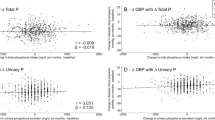Abstract
Objectives: Evaluation of the impact of a coronary heart disease prevention program on calcium, magnesium, phosphorus and vitamin D dietary intake in respect of recommended daily allowances in a large Italian rural population.
Design: Retrospective analysis of the Brisighella Study dietary data. The Brisighella Study started in 1972 as a longitudinal study on atherosclerosis risk factors.
Setting: Brisighella, a rural North Italian village.
Subjects: The Brisighella population's dietary habits were monitored from 1980 every 4 h through a dietary record sheet. 1350 constantly tested subjects were subdivided according to NHI Consensus Conference on Calcium RDA.
Intervention: In 1986, the studied subjects were invited to reduce their consumption of animal fats and cholesterol through a Nutrition Educational Program (NEP).
Results: Before NEP, calcium intake was low in each sex and age category: 20–40% of the populatioin had a daily intake <550 mg. In 1988, among the 1350 subjects who constantly completed the questionnaire (M=651, F=699), the mean calcium intake significantly rose in all age categories: M=1003 (25–65 y) and 877 (>65) mg/24 h (P<0.001 vs 1984); F=923 (25–50), 860 (51–65) and 767 (>65) mg/24 h (P<0.05). In 1992, 3 y after the NEP conclusion, calcium intake dropped in each sex and age category. The NEP influenced vitamin D, phosphorus and magnesium intakes less.
Conclusions: A collective NEP aimed at lowering saturated fats and cholesterol intakes, improves the calcium intake; in order to maintain their efficacy on nutritional habit changes, these programs must become an ongoing item.
European Journal of Clinical Nutrition (2001) 55, 97–106
This is a preview of subscription content, access via your institution
Access options
Subscribe to this journal
Receive 12 print issues and online access
$259.00 per year
only $21.58 per issue
Buy this article
- Purchase on Springer Link
- Instant access to full article PDF
Prices may be subject to local taxes which are calculated during checkout
Similar content being viewed by others
Author information
Authors and Affiliations
Contributions
Guarantor: A Gaddi.
Contributors: Prof Gaddi is responsible for the Brisighella Heart Study and ideator, guarantor and coordinator of the present research; Dr D'Addato represents the original Brisighella Heart Study medical staff and supervised the research; Dr AFG Cicero is responsible for the final version of the manuscript and for the study data processing with Dr Ada Dormi; Dr Odo Wani and Dr Pasquarelli co-operated at various levels in the paper elaboration.
Corresponding author
Rights and permissions
About this article
Cite this article
Gaddi, A., Cicero, A., Odo Wani, F. et al. The realization of a project aimed at reducing the plasmatic lipid level in a large Italian population improves the mean calcium daily intake: the Brisighella Study. Eur J Clin Nutr 55, 97–106 (2001). https://doi.org/10.1038/sj.ejcn.1601123
Received:
Revised:
Accepted:
Published:
Issue Date:
DOI: https://doi.org/10.1038/sj.ejcn.1601123
Keywords
This article is cited by
-
Osteoporosis is a Predictive Factor for Nephrolithiasis in an Adult Free-Living Caucasian Population From Southern Italy: A Longitudinal Retrospective Study Based on a General Practice Database
Calcified Tissue International (2020)
-
Population Health Needs Assessment and Healthcare Services Use in a 3 Years Follow-Up on Administrative and Clinical Data: Results from the Brisighella Heart Study
High Blood Pressure & Cardiovascular Prevention (2014)
-
Healthy Diet to Prevent Cardiovascular Diseases and Osteoporosis
High Blood Pressure & Cardiovascular Prevention (2012)
-
Psyllium improves dyslipidaemia, hyperglycaemia and hypertension, while guar gum reduces body weight more rapidly in patients affected by metabolic syndrome following an AHA Step 2 diet
Mediterranean Journal of Nutrition and Metabolism (2010)
-
Haemoglobin levels are associated with bone mineral density in the elderly: a population-based study
Clinical Rheumatology (2009)


